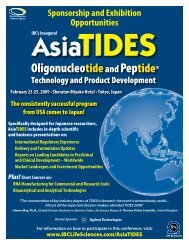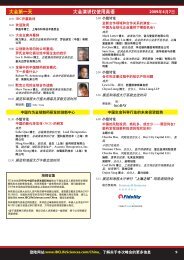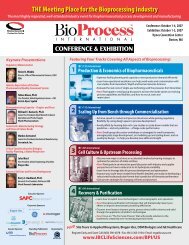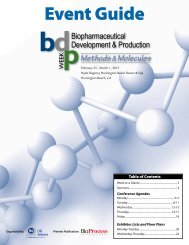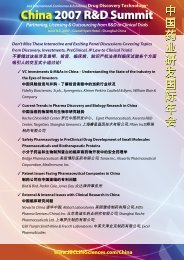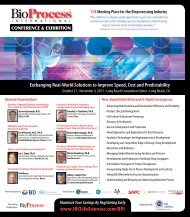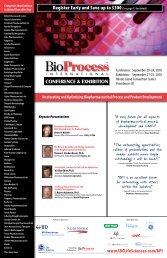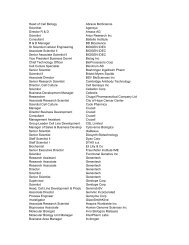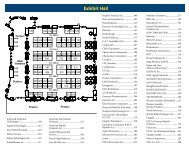The Finalists - IBC Life Sciences
The Finalists - IBC Life Sciences
The Finalists - IBC Life Sciences
Create successful ePaper yourself
Turn your PDF publications into a flip-book with our unique Google optimized e-Paper software.
<strong>The</strong> Technology<br />
of the Decade<br />
Award recognizes<br />
game-changing<br />
innovations in<br />
equipment,<br />
raw materials<br />
and/or tools<br />
that significantly<br />
transformed drug<br />
development and<br />
manufacturing,<br />
improving process<br />
efficiency and<br />
accelerating<br />
market entry.<br />
Technology of the Decade — <strong>The</strong> <strong>Finalists</strong><br />
Technology:<br />
Company:<br />
<strong>The</strong> PlEx-iD system for rapid Microbial Detection<br />
Abbott laboratories–ibis Biosciences<br />
Initiatives such as QbD and PAT call for better control of manufacturing<br />
process to ensure final quality. Originally designed for biothreat and publichealth<br />
applications, the PLEX-ID system offers rapid, broad detection and<br />
identification of known and emerging organisms from multilocus base composition analysis.<br />
<strong>The</strong> genotypic system uses PCR amplification followed by MS detection to identify viruses, bacteria,<br />
or fungi within eight hours, direct from sample to results. <strong>The</strong> PLEX-ID system enables manufacturers to<br />
better control their process from cell banks to final products, guarding against virus contamination and<br />
ensuring rapid identification of excursions of adventitious agents.<br />
Technology:<br />
iBD inline Buffer Dilution systems<br />
Company:<br />
Asahi Kasei Bioprocess<br />
Increased protein titers from upstream processes require substantial quantities of diluted buffers for<br />
downstream processing. Introduced in 2007, IBD systems help manufacturers prepare 1× binary and<br />
ternary buffer blends from ≤20× salt-solution concentrates for purification. Process analytical technology<br />
controls pH and conductivity simultaneously, and large buffer tanks are replaced with disposable bags.<br />
<strong>The</strong> systems minimize batch variation and reduce the need to discard/reprocess buffers that fail required<br />
specifications. Direct cost savings come from reduced capital expenses for large-volume buffer hold<br />
tanks, reduced operating costs (offline buffer QC, tank cleaning, and cleaning validation), and improved<br />
turnaround times.<br />
Technology:<br />
Planova virus-removal Filters<br />
Company:<br />
Asahi Kasei Bioprocess<br />
DOWNSTREAM<br />
Planova virus-removal filters eliminate viruses from mammalian cell lines or human plasma during<br />
biotherapeutic production. Building on the success of the world’s first virus-removal filter (Planova<br />
35N, introduced in 1989), the family expanded in this past decade to include Planova 15N (the world’s<br />
first parvovirus removal filter) and Planova 20N, with respective mean pore sizes of 15 nm and 20<br />
nm. By combining robust performance with unique scalability, this family of filters accommodates<br />
development through commercial projects. <strong>The</strong> filters combine reliable, high-throughput filtration with<br />
maximum product recovery and virus retention, removing endogenous and adventitious viruses without<br />
compromising product viability.<br />
2012 BioProcess international awards





